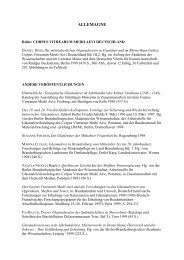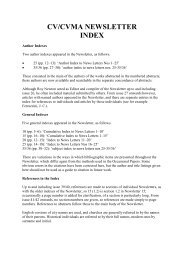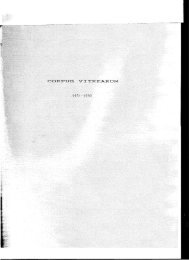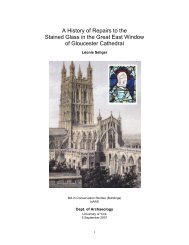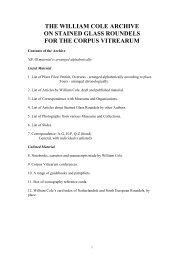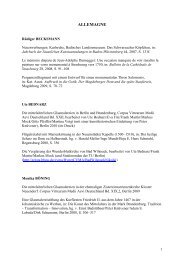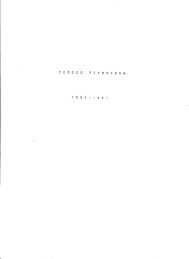BristolConference - Corpus Vitrearum Medii Aevi
BristolConference - Corpus Vitrearum Medii Aevi
BristolConference - Corpus Vitrearum Medii Aevi
You also want an ePaper? Increase the reach of your titles
YUMPU automatically turns print PDFs into web optimized ePapers that Google loves.
Prof. Jonathan Alexander<br />
(New York University)<br />
Patronage and the Relations of Stained Glass with other Media, particularly Sculpture, Wall<br />
Painting and Manuscript Illumination<br />
The paper will aim to integrate the study of stained glass surviving in England with the<br />
study of other media, particularly sculpture, wall painting and manuscript illumination.<br />
The first part of the paper will examine the changes in style in the second quarter of the<br />
fifteenth century away from the 'International Gothic' style towards the 'ars nova' of the<br />
Netherlands. It will ask how far glass painters can be considered to have been leaders in<br />
this stylistic development, e.g. glass at All Souls College, Oxford and Great Malvern. The<br />
second part will turn to an iconographic theme, that of genealogy and succession. I plan<br />
to compare royal and magnate imagery in glass, for example at Malvern, York Minster,<br />
St Mary's Warwick, with that in illuminated manuscripts.<br />
Dr Eva Fitz<br />
(Arbeitsstelle fur Glasmalereiforschung<br />
des CVMA, Potsdam)<br />
Das Retabel aus der Schlosskirche in Wernigerode und die Clasmalerei im Halberstadter<br />
Dom<br />
Gegenstand meines Vortrags ist das Cedachtnisretabel fur den 1386 hingerichteten Grafen<br />
Dietrich von Wernigerode im Hessischen Landesmuseurn Darmstadt, das vermutlich in<br />
Halberstadt entstanden ist. In der Kunstgeschichtsliteratur gilt es aufgrund motivischer und<br />
stilistischer Ahnlichkeiten als ein Werk aus del' weitlaufigen Nachfolge des Conrad von<br />
Soest, es wird daher zwischen 1404 und l420/30 datiert. Anhand verschiedener um 1400<br />
entstandener Kunstwerke lasst sich jedoch belegen, dass die Marienszenen Motive<br />
aufgreifen, die damals in Sudniedersachsen gelaufig waren. Auch stilistisch stehen einige<br />
dieser Werke den Malereien des Retabels naher als die Cemalde des Wildunger Altars.<br />
Einige Details lassen vermuten, dass das Retabel schon vor 1400 ausgefUhrt wurde,<br />
wahrscheinlich bereits wenige [ahre nach dem Tod des Grafen, um 1390/95. Es zahlt damit<br />
zu einem der fruhesten Zeugnisse des Internationalen Stils im Bistum Halberstadt.<br />
Stilistisch und motivisch liegen hier die Voraussetzungen fur eines del' wenige [ahre spater<br />
im Dom tatigen Glasmalereiateliers.<br />
An Altarpiece from the Castle Chapel in Wernigerode and Stained Glass in Halberstadt<br />
Cathedral<br />
The subject of my lecture is the memorial altarpiece for Count Dietrich of Wernigerode, who<br />
was put to death in 1386. Now in the Hessisches Landesmuseum, Darmstadt, it was<br />
presumably produced in Halberstadt. On the grounds of similarities in style and<br />
iconography, it has been seen, in the art-historical literature, as a work distantly related to<br />
Conrad von Soest and dated between 1404 and 1420/30. Yet, comparison with various<br />
works of c.1400 shows that the Marian scenes contain motifs that were common in Southern<br />
Lower Saxony at the time. Stylistically, also, the retable is closer to these works than to<br />
Conrad's Wildung altarpiece. Various details lead to the conclusion that it was painted<br />
before 1400, probably only a few years after the death of the Count, about 1390-95.<br />
Consequently, it must be reckoned among the earliest examples of the International Gothic<br />
style in the Bishopric of Halberstadt. In both style and iconography, it is an immediate<br />
forerunner of the glass workshop active a few years later in Halberstadt Cathedral.<br />
8



